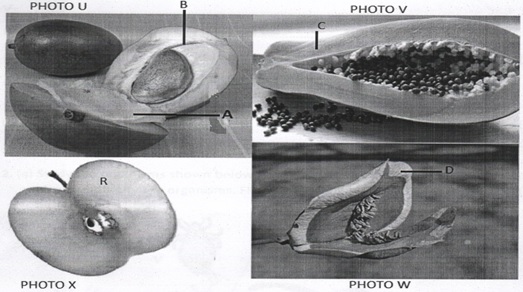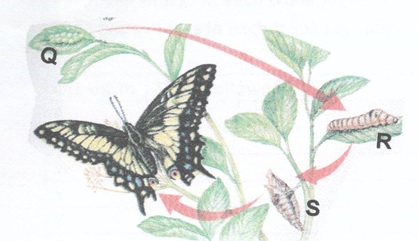Question 1
Study the photographs U, V, W and X showing fruit specimens that areopen to expose the interna partsl.

- Name the parts labeled A, B, C and D
A
B
C
D - Identify the type of fruit in photograph:
i. U
ii. W - What type of placentation is found in the following fruits:
U
V
W - How is the specimen in photograph W adapted to its functions?
- Which part of a flower develops into the region labeled R in the photograph X
Answer
-
A - Endocarp
B - Funicle
C - Mesocarp
D - Pericarp -
i. U - Drupe/Fleshly
ii. W - Dry dehiscent/Dry -
U - Basal
V - Parietal
W - Marginal - Has lines of weakness/sutures/lines of dehiscence to split and allow seeds to be thrown out.
- Receptacle
Question 2
Below is a diagram showing a type of metamorphosis exhibited by a butterfly

- Give the name of the type of metamorphosis in the diagram above.
- Write down two importance of metamorphosis.
- Name stages Q and R
Q
R - Differentiate the biological activities in the development stages R and S.
- Name the two major hormones that are associated with metamorphosis in insects.
- (i) Name the class to which the organisms in the diagram above belongs.
(ii) Give a reason for your answer in f (i) above
Answer
- Complete metamorphosis.
- 1. Reduces competition for food due to occupation of different ecological niches.
2. Enables the organisms to escape harsh climatic conditions e.g at pupa stage. -
Q - Egg
R - Caterpillar -
R S Feeds actively Non feeding stage Moults severally Does not Moult Grows rapidly Does not grow in size Locomotes Stationary - - Ecdysone hormone
- Juvenile hormone - (i) Class: Insecta
(ii) - Body divided into 3 pairs head, thorax and abdomen
- Head one pair of antennae
- Head has a pair of compound eyes
- The insect undergoes complete metamorphosis
